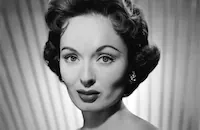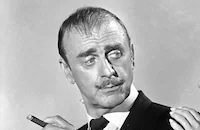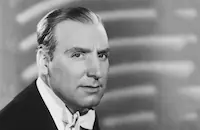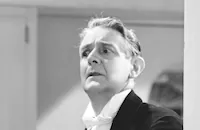The King's Thief

Brief Synopsis
Cast & Crew
Robert Z. Leonard
Ann Blyth
Edmund Purdom
David Niven
George Sanders
Roger Moore
Film Details
Technical Specs

Synopsis
In 17th century England, James, Duke of Brampton, calls on King Charles II to sign a death warrant against yet another former ally now accused of treason. As the duke departs, a notebook falls out of his coat, and he nervously retrieves it before the king can look inside. Meanwhile, in Normandy, Sir Edward Scott calls on Lady Mary, who has been in exile for ten years, and sadly reports that her father has been hanged for treason. Edward reads a letter from Mary's late father, alluding to the king's treacherous counselors, then mentions rumors that half of what Brampton confiscates for the crown goes into his own pocket. Enraged, Mary vows to return to England and avenge her father. One night, Brampton's coach is waylaid by masked highwaymen, who take his notebook along with his possessions. Later, at the highwaymen's hideout in a tavern, fence Henry Wynch refuses to buy the jewels, and their leader, Michael Dermott, deduces the identity of their victim. Michael inspects Brampton's book and finds it contains the names of various noblemen, along with a complete accounting of their wealth and a date. Later, Mary goes to an exclusive gambling club in London and seats herself at Brampton's table. After Mary has lost all her money and a broach, Michael approaches and places the stolen jewels on the table, offering to redeem her losses. Michael discreetly mentions the notebook, promising to contact the duke later. Michael escorts Mary to her lodgings, and tells her that he and his men fought in the militia restoring the king to the throne but were never paid. Mary tells Michael about her father, and he is about to kiss her when Brampton and his men show up. Brampton says Michael has been heard uttering treasonous remarks, and suggests that he might save his life by returning the notebook. He sends Michael with his men to retrieve the book, but Michael's cohorts rescue him. Later, the thieves realize that the first two names in the duke's notebook are those of men recently hanged for treason, and speculate that the other people on the list might be willing to pay for information about their scheduled execution. The duke's men suddenly show up, and Michael is shot and wounded while escaping with his comrade Jack. They take refuge at the home of a Quaker family, who promptly take Michael in and tend his wounds. In the morning, Jack returns with Mary, and Michael shows her the book. Just then, Brampton shows up with his men and, after defeating Michael in a fencing match, arrests Michael and Jack and retrieves the book. Michael's two other comrades, Sheldon and Skene, remain at large, however, and Brampton orders Mary to go to Michael's cell that night and learn their whereabouts, threatening to deport her to the colonies if she fails. At the prison, Mary gives Michael a knife and urges him to escape, and Michael tells her the name of their hideout. In the coach to Brampton's, Mary feigns illness and asks to be taken to the apothecary, who is the son-in-law of her loyal servant Simon. Simon is waiting there for her, and he and his family help Mary escape. Meanwhile, Michael uses the knife to remove his and Jack's leg irons, and they manage to tunnel out of their cell and up into the prison's bell tower. Using a length of rope from the bell, they painstakingly lower themselves down the outside of the fortress and escape. Simon is waiting for them at the tavern, and takes them to his quarters, where Michael is happily reunited with Mary. Brampton's aide, Capt. Herrick, who was taken prisoner during Mary's escape, reveals everything about the duke's scheme, which is due to culminate in the overthrow of the king. Herrick says he thought of warning the king, but realized that an audience with Charles can only be arranged through Brampton. Michael then hatches a plan to steal the Crown jewels in order to gain access to the king. Posing as Brampton's cousin and his wife, Michael and Mary go to the Tower of London and are given a private tour of the jewels. While Mary has the caretaker, Sir Gilbert Talbot, show her the observatory, Michael smashes the glass case and steals the jewels, then battles with the enormous guard, Jacob Hall. Michael and Mary's escape is interrupted, however, by the arrival of Charles and the duke. Kneeling before the king, Michael and Mary reveal Brampton's plot, and Michael and the duke engage in a fierce sword fight. After defeating the duke, Michael demands the book and gives it to the king. Later, after the duke has been hanged, Charles summons Michael, and each of his men receives a generous annual income to work in his service. As the king fondly looks on, Michael and Mary kiss.

Cast

Ann Blyth

Edmund Purdom

David Niven

George Sanders
Roger Moore

John Dehner
Sean Mcclory
Tudor Owen

Melville Cooper

Alan Mowbray

Rhys Williams
Joan Elan
Charles Davis
Ashley Cowan

Ian Wolfe

Paul Cavanagh
Lillian Kemble Cooper

Isobel Elsom
Milton Parsons
Lord Layton

Queenie Leonard
Owen Mcgiveney
Bob Dix
Michael Dugan
James Logan
Gilchrist Stuart
Ramsey Hill
Vesey O'davoren
Gordon Richards
Trude Wyler
Keith Mcconnell
Lewis L. Russell
Matt Moore
Ronald Green

Leonard Carey
Leslie Denison
Charles Keane
Clive Morgan
John Monoghan
Jimmy Aubrey
Peter Hansen
Trevor Ward
Crew
Robert Hardy Andrews
James Brock
Malcolm Brown
Alvord Eiseman
Cedric Gibbons
Sydney Guilaroff
Ed Haight
Jean Heremans
Christopher Knopf
Edwin H. Knopf
John Lipow
John Mcsweeney Jr.
Wesley C. Miller
Warren Newcombe
Richard Pefferle
Scott Perry Sr.
Robert Planck
Walter Plunkett
Miklos Rozsa
Robert Saunders
Al Shenberg
William Tuttle
Edwin B. Willis

Film Details
Technical Specs

Articles
The King's Thief
The King's Thief was the final MGM film of director Robert Z. Leonard. The movie was originally put under the direction of Hugo Fregonese. But eleven days into filming, Fregonese was taken ill and production halted. According to a report in Daily Variety, disagreements between Fregonese and the film's producer, Edwin H. Knopf, kept Fregonese from returning to The King's Thief after he recovered. So Leonard, a career MGM man who had basically gone into retirement after 31 years at the studio, was called in to direct the picture. Leonard was unquestionably a prolific director who turned out popular and entertaining films, though he would later be cited by film critic Andrew Sarris as a case against auteurism (Sarris suggested that Leonard's success could be attributed more to his screenwriters, actors and other contributors rather than Leonard's directorial skills). Leonard's hits over the years included Pride and Prejudice (1940), several Nelson Eddy/Jeanette MacDonald confections such as Maytime (1937) and New Moon (1940), as well as the Judy Garland-Van Johnson musical In the Good Old Summertime (1949). Leonard would make just one more film after The King's Thief - Kelly and Me (1957), released by Universal-International and starring Van Johnson and Piper Laurie.
Also worth noting in The King's Thief is a young, pre-Bond Roger Moore who has a small role in the picture. Though Niven and Moore first met on the film, the star and the newcomer already had a curious connection. Niven's first novel Round the Rugged Rocks had been published in England and serialized in a woman's magazine. The magazine used models to illustrate the story and Moore had posed as the hero of Niven's story for the serial.
The real story that inspired The King's Thief is also an interesting tale. The movie centers around a plot to steal back the Crown Jewels on behalf of the King from an evil Duke. There was, in fact, an attempt to steal the Crown Jewels during Charles II's reign. The real thief's name was Thomas Blood and he made an infamous attempt to steal the Crown Jewels in 1671. Blood worked his way inside the Tower of London by befriending the jewel keeper and then convinced the unwitting guard to show the jewels to some friends. Blood and his crew then knocked out the jewel keeper and stole several pieces. But they were quickly captured, never even making it outside the walls of the Tower. For undocumented reasons, Charles II pardoned Blood. This has led historians to speculate that it was perhaps an inside job. The jewels, which were created for Charles II, may have been intended to be broken up and sold to replenish the Royal Treasury.
There's one final interesting point about the film - its casting of Charles II. The King's Thief marked George Sanders' second time playing the monarch. He first played Charles II in Forever Amber (1947). Talk about type casting!
Producer: Edwin H. Knopf
Director: Robert Z. Leonard
Screenplay: Robert Hardy Andrews (story), Christopher Knopf
Cinematography: Robert Planck
Film Editing: John McSweeney, Jr.
Art Direction: Malcolm Brown, Cedric Gibbons
Music: Miklos Rozsa
Cast: Ann Blyth (Lady Mary), Edmund Purdom (Michael Dermott), David Niven (Duke of Brampton), George Sanders (Charles II), Roger Moore (Jack), John Dehner (Capt. Herrick).
C-79m. Letterboxed. Closed captioning.
by Stephanie Thames

The King's Thief
Quotes
Trivia
Notes
The opening credits include the following written prologue: "When Charles II was King of England it was said-He never spoke a foolish word nor listened to a wise one. This is the story of how a thief-more foolish than wise-finally made him listen." The Hollywood Reporter review noted that the actual quote, by John Wilmot, Earl of Rochester, was: "He never says a foolish thing nor ever does a wise one." According to Hollywood Reporter news items, Hugo Fregonese was the film's original director, but production was halted after eleven days when Fregonese was stricken with a virus. Director Robert Z. Leonard, who had recently gone into retirement, was called to take over. The King's Thief was Leonard's last film for M-G-M, after thirty-one years with the studio. A January 12, 1955 Daily Variety news item stated that Fregonese would not return to the film when he recovered because of disagreements with producer Edwin H. Knopf.
A September 1954 Hollywood Reporter news item noted that Michael Wilding was at that time to be Edmund Purdom's co-star. January 1955 Hollywood Reporter news items add Barry Regan, Julian Smith, Saul Gorss, Chuck Hayward, LeRoy Johnson, Tap Canutt, Joe Canutt, Phil Schumacher, Clint Sharp, John Eppers, Danny Sands, Curly Gibson, Helen Morgan and Mary Hawkins to the cast, but their appearance in the final film has not been confirmed. George Sanders, who played King Charles II in the film, also portrayed Charles II in the 1947 Twentieth Century-Fox film Forever Amber (see AFI Catalog of Feature Films, 1941-50). Screenwriter Christopher Knopf was the son of producer Edwin H. Knopf.

Miscellaneous Notes
Released in United States Summer August 1955
CinemaScope
Released in United States Summer August 1955















